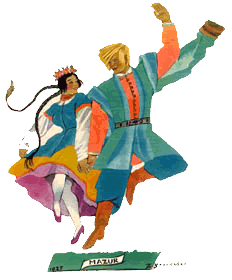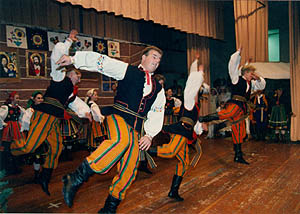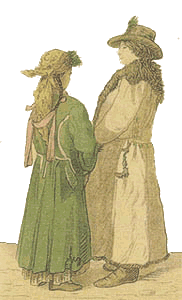HISTORY
The mazur and mazurek (i.e. small
mazur), or in English mazurka, are general terms for
a series of Polish folk dances in triple meter, which originated in
the plains of Mazovia around Warsaw. The people of the province were
called Mazurs; thus, the dance mazur bears the same name as
the male inhabitant of the region. The dances, known abroad as mazurkas,
comprise more than one type: mazur or mazurek, the obertas
or oberek, and the kujawiak from the neighboring district
of Kujawy. These dances are linked by common rhythmic and choreographic
traits, especially the mazurka rhythm discussed below. The
name is much younger than the dance itself, and probably originated
outside of the region. This term appears for the first time in J.
Riepel's music dictionary published in Germany in 1752.

|
The dance was known as early as the 16th century; early lute and organ tablatures feature many instances of the mazurka rhythm in pieces entitled Polish dance, or in Latin, Chorea polonica. During the 17th century the dance spread over Poland and began to appear also in neighboring countries; distinct versions of these dances could be found in the repertoire of the countryside (the folk mazur-type dances and the mazur of the nobility), and the towns (urban mazurka).
Left: Zofia Stryjeńska, 1927. |
|---|
Augustus II, the Elector of Saxony and King of Poland (1697-1733) was very fond of this dance and introduced it into the courts of Germany. Following Poland's loss of independence, the dance became fashionable in higher social circles in Paris, then London, and other centers of Western Europe. In 1830, the British paper The Observer (25 April 1830) described the mazurka as "just introduced, or intended to be introduced, into this country." In the 1830s and 1840s, the mazurka enjoyed its greatest popularity in the Western salons; along with the krakowiak and the polonaise, it served as a sign of solidarity with the oppressed Polish nation, the cause championed by Polish exiles in Paris and their aristocratic patrons. Paradoxically, after the partitions of Poland, the mazurka also became popular among the Russian aristocracy and peasantry.
An important fact in the history of the mazurka
is its appearance in the Polish national anthem. Mazurek Dąbrowskiego
(Dąbrowski Mazurka) was created in 1797 as a Song of the Polish Legion
for the troops of General Jan Dąbrowski, serving Napoleon during his
conquest of Europe with the hope of regaining Poland's independence.
The melody of the anthem is of anonymous, folk origin; the text was
penned by Józef Wybicki (for more information visit the PMC National
Anthems Site). Thus, the fast-paced, energetic dance became a national
symbol in several distinct ways.
DESCRIPTION
 |
Oskar Kolberg stated in the first volume of his monumental folklore collection, Pieśni ludu polskiego (Songs of the Polish people 1857), that kujawiak, i.e. obertas, is the most popular dance in the whole country. In his later writings, Kolberg distinguishes between these dances differing in tempo, with the mazur occupying the middle ground between the slow, lyrical kujawiak and the furiously fast-paced oberek. Moreover, he describes a performance practice of dancing a set of three dances, a chodzony (walking dance, folk version of the polonaise), followed by a kujawiak, and a mazur or an obertas (oberek). Left: State Group, Mazowsze, 1964. |
|---|
This confusion of terminology and typology arose because of the great
popularity of these dances and the existence of many regional variants.
According to the New Grove Dictionary of Music and Musicians, the
mazurkas "that remained unaltered by influences of urban music seem to
have no definite ending, as the repeats are made ad libitum, or their
concluding bar finishes on the dominant on the third beat, without accent
leaving the impression of disappearance into the air [...] A certain pride
of bearing and sometimes a wildness sharply differentiate its mood from
that of the more sensuous waltz. The dance has the character of an improvisation,
and is usually danced by four, eight or 12 couples, but sometimes by an
indefinite number of dancers."
 |
The folk dance is improvisatory in character; it is danced by couples who rotate around the dance hall and present a variety of gestures. As an "exhibition" dance it is regarded as the "most exciting and intricate of the five national dances of Poland" (Ada Dziewanowska: Polish Folk Dances and Songs, p. 509). Dziewanowska described the mazur as filled with contrasts: "it combines the fiery spirit with pride and elegance, vivacity with lyricism, dignity with joy, and boldness with gallantry." Left: Krakusy in Mazur, 1999. |
|---|
The position of the body resembles that of the polonaise - head held
high, torso erect, graceful motion of the hands. The difference of the
character stems primarily from the faster tempo and the presence of irregularly
spaced accents, stomps and clicks of the boots. There are four versions
of the mazur that could be presented by a folk dance group: the
dance of the nobility (in 17th-century costumes), the salon dance of the
Napoleonic era (in the appropriate military [men] and salon [women] mixture
of clothing), the dance of urban folk or a peasants' dance from central
Poland. Each type of dance would emphasize different class characteristics
of portrayed strata of Polish society.
 |
There are a number of basic steps: bieg mazurowy (running step), sideways step, sliding step, and the hołubiec (clicking heels together, similar to the step in the krakowiak). There are also many hand positions, figures, and turns that could be used by couples performing this dance. A different set of group figures is available for ensembles. Thus, the dance leaves much room for the creativity of its choreographer and the spontaneity of individual dancers. Left: Krakusy, the hołubiec step, 1999. |
|---|
COSTUMES
Since there are at least four different socio-historical versions of the mazur (17th-century nobility, 19th-century patriotic society, peasants from central Poland, regional varieties from western and south-central Poland, etc.), there are a variety of costumes available for performance.
 |
If the version of the nobility is chosen (at times to music from the classical tradition, e.g. the Mazur from Stanisław Moniuszko's The Haunted Manor), the clothing should be that of the 17th-century Polish nobility wearing fur-lined jackets (kontusz) and hats. (For more information about this type of costume, see the entry on polonaise). The Polskie Iskry wear a stylization of this costume with women wearing shorter skirts and different shoes that would have been used by the Polish gentry. Left; Polskie Iskry, 1980s. |
|---|
The "high-society" mazur may also be performed by the 19th-century Polish legionists (in Napoleonic uniforms, and special square hats bearing the national emblem, an eagle on the front) and their charming partners in Empire gowns, long gloves and at times light, flowing scarves covering their almost-bare shoulders (see polonaise for a more detailed description of this costume).
 |
The regional costumes used by Polish folk dance ensembles differ considerably from historically documented clothes worn by peasants from the region in the 19th century, for instance the couple from Raszyn, near Warsaw, as represented in Oskar Kolberg's Pieśni ludu polskiego (1857). Left: Costume from Mazovia, Kolberg, 1857. |
|---|
Nonetheless, the dance groups prefer to present the mazur as
the dance of the nobility, reserving the folk costumes for performances
of the faster and slower variants, i.e. the oberek and kujawiak.
It is also possible to find mazur-type dances in Wielkopolska,
Małopolska, or Lubelskie - indeed, with the richness of
costumes and the variety of variants available, the mazur truly
is a national dance and may appear in suites of dances from all these
regions.
MUSIC
 |
|
||||
|---|---|---|---|---|---|
In the music, strong accents are irregularly placed on the second or
third beat of the measure. There is also a marked tendency to end the
phrase on the dominant pitch located on an unaccented third beat in the
measure. The tempi vary greatly between the various types of the dance,
and also geographically (the dances are faster in southern Poland than
in the northern part of the country). The oberek or obertas
is usually the fastest, with MM=160-180; while the regular mazur
is performed in the tempo range of MM = 120-40 (the kujawiak is
still slower).

|
|
|---|
A singer would then improvise the melody, and sometimes even the text
of the couplets, to this stable accompaniment. The most common ensemble
performing in the Mazowsze region consists of a violin, a large drum (as
depicted below, from the Ethnographic Museum in Warsaw), and later, a
Polish folk accordion (with three registers, harmonia trzyrzędowa),
and clarinet.
 |
|
|---|
The introduction of the mazurka to art music is usually credited to Fryderyk Chopin, though his predecessors included Maria Szymanowska, and others. While Chopin's borrowings from folk, urban, or salon types of the mazurka have been extensively discussed by scholars (e.g. Mieczysław Tomaszewski, Elżbieta Witkowska, Barbara Milewski), certain melodic, harmonic, rhythmic and formal traits point to their close relationship with the idiosyncratic features of the folk mazur-type dances. Several stylized mazurs of the nobility appear in the stage music of Stanisław Moniuszko (operas Halka and Straszny Dwór [The Haunted Manor]). Other Polish composers interested in the mazurka include Aleksander Tansman, Karol Szymanowski, and Roman Maciejewski.
In America, the mazurka (the title was usually in this spelling) appeared in 1840s; salon composers wrote the mazurkas as dances associated with Poland and its celebrated loss of independence, or as fashionable dances dedicated to society ladies. In some variants the mazurka is crossed with the polka - a salon dance, not its folk counterpart. Aleksander Janta lists about 30 mazurkas in his study of nineteenth-century American-Polish music (1982, 128); one publication describes the mazurka as a Russified dance: "The Mazourka is the national dance of Poland, and was introduced into Russia when the Russians subjected Poland. The Russians dance, or rather walk, the Mazourka with a dignified air, but they lack the natural animation and graceful ease adapted by the Poles" (from an 1845 New York edition of A Set of Mazurkas and a Set of Polkas by Coote and Glover).
SOURCES OF MATERIAL
- Burhardt, Stefan. Polonez. Katalog Tematyczny (Polonaise:
Thematic catalogue), 3 vols. Kraków: PWM Edition, 1976.
- Dąbrowska, Grażyna. Taniec ludowy na Mazowszu [Folk dance
in Mazovia]. Kraków: PWM Edition, 1980.
- Dziewanowska, Ada. Polish Folk Dances & Songs: A Step by Step
Guide. New York: Hippocrene Books, 1999.
- Harley, Maria Anna. "Dance as a National Symbol: Polish Dance in Southern
California." Project for Southern California Studies Center at USC,
August 2000.
- Janta, Aleksander. A History of Nineteenth Century American-Polish
Music. New York: The Kościuszko Foundation, 1982.
- Kolberg, Oskar: Pieśni ludu polskiego [Songs of the Polish
people], vol. 1 of Dzieła Wszystkie [Complete Works]. Wrocław-Poznań:
Polskie Towarzystwo Ludoznawcze, 1962. Reprint of a 1857 publication.
- "Mazur, mazurek," entry in Encyklopedia Muzyki PWN. Warszawa:
PWN, 1994.
- "Mazurka," entry in the New Grove Dictionary of Music and Musicians,
vol. 11. Stanley Sadie, ed. London: McMillan, 1980.
- Windakiewiczowa, Halina. Wzory polskiej muzyki ludowej w mazurkach
Fryderyka Chopina. [Patterns of Polish folk music in F. Chopin's
mazurkas]. Warsaw, 1926.
- Illustrations from Polish folk art (straw cutouts); Zofia Stryjeńska's
1927 "Mazur" image; photographs from the PMC Collection and from archival
material gathered for M.A. Harley's Polish Dance in Southern California
project.